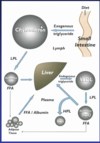CHEMPATH: Lipids Lecture Flashcards
Name some features of atherosclerosis lesions.
- Fibrous cap
- Foam cells - contents of macrophages exude if squeezed
- Necrotic core with cholesterol crystals
What are the types of lipoproteins from biggest to smallest?
- Chylomicrons
- VLDLs - both rich in triglycerides
- LDLs - main carriers of cholesterol
- HDLs

How is cholesterol transported?
- <5% in chylomicrons
- 13% VLDL
- 70% LDL - major transporter
- 17% HDL

Summarise cholesterol absorption and metabolism.

How is cholesterol transported across the intestinal brush border?
Via NPC1L1- goes into lymphatics and then into liver
Which transporters transport cholesterol back into the intestinal lumen?
ABC-G5 and ABC-G8.
The balance between NPC1L1 and the above taransporters determined how much cholesterol gets absorbed.
Where are bile acids absorbed?
Terminal ileum and transported using BAT
What is the function of HMG CoA reductase in the liver?
It converts acetate into mevalonic acid(MVA) which is converted into cholesterol.
What is the relationship between cholesterol absorption of cholesterol and its synthesis in the liver?
Those who have high absorption will have low synthesis of it and vice versa
What is the fate of cholesterol after its synthesis in the liver or absorption?
It is broken down into bile acids (by 7-alpha hydroxylase)
OR esterified into cholesterol ester (by ACAT) and incorporated into VLDL particles with apoprotein B and triglcerides (using a transfer protein MTB)
What is the precursor of LDL? When does the change occur?
VLDL changes into LDL after its circulation in plasma for 3-4 days. LDL is then taken up into the liver by the LDL receptors.
What is the function of HDL? Which transporter is important in this effect?
Picks up excess cholesterol from the peripheries. ABC A1 is very important in the process of transfer of cholestrol from the peripheries into HDL.
What is the role of CETP (cholesterol ester transfer protein)?
Mediates the movement of:
- cholestrol ester from HDL to VLDL
- and movement of triglycerides from VLDL to HDL.
What is the role of SR-B1 receptor on the liver?
Transfer of cholesterol ester from HDL into the liver
What are the main compartments/organs involved in cholesterol metabolism?
- Liver
- Intestine
- Plasma
How are triglycerides transported in the fasting state?
<5% chylomicrons (short half life in plasma)
55% VLDLs (major transporter of TG)
29% LDLs
11% HDLs

Summarise TG transport and metabolism.

- Main source of TG is small intestine from fatty foods
- These are transported by chylomicrons into plasma
- Plasma into lipoprotein lipase in capillaries hydrolyses chylomicrons into free fatty acids (FFAs)
- FFAs are taken up into (1) the liver and (2) adipose tissue
- In the liver, the FFAs are remade into TGs and transported by VLDLs
- VLDLs are again hydrolysed by lipoprotein lipase into FFAs (ad IDL remnant) and LDLs
Name 4 types of primary hypercholesteroleaemia. What genes are involved?
- Familial hypercholesterolaemia (type II): Dominant mutation of the LDL receptor, apoB or PCSK9 genes. 50% expression in the heterozygous state. Rarely it is also inherited in autosomal recessive inheritance (LDLRAP1)
- Polygenic hypercholesterolaemia: multiple loci including NPC1L1, HMGCR, CYP7A1 polymorphisms with small effects
- Familial hyper-alpha-lipoproteinaemia: sometimes CETP deficiency, causes increases in HDL
- Phytosterolaemia: mutations of ABC G5 and G8 (found in small intestine). Plant sterols will move into plasma in this disorder and cause premature atherosclerosis as they may be more atherogenic.
What does this show?

LDL binds to “coated pit” on the liver which then invaginates and causes its uptake into the liver
How does severity of familial hypercholesterolaemia vary?

Mutations causing changes to different parts of the LDL receptor have different effects on severity.
How common is homozygous familial hypercholesterolaemia(FH)?
About 1 in a million
May present as corneal arcus in a child etc. or cholesterol levels of 30 mmol/L from birth onwards.
How common is heterozygous FH?
1:500 many undiagnosed
Will have xanthelasma and corneal arcus around age 40 and tendon xanthoma (thick lump on the Achilles’ tendon)
What is the function of PCSK9 and its role in primary hypercholesterolaemia?
PCSK9 =proprotein convertase subtilisin/kexin type 9
Chaperone protein , binds the LDL receptor and promotes its degradataion.
- A gain of function mutation in this will cause increased LDLR degradation so LDL will not be bound and taken up at the normal rate.
- Loss of function mutations are associated with low LDL levels.
What are the causes of primary hypertriglyceridaemia?
- Familial type I - LPL (degrades chylomicrons) or apoC II (its activator) deficiency
- Familial type IV - increased synthesis of TG (not decreased clearance), unknown cause
- Familial type V - sometimes due to apoA V deficiency (a more sever version of type IV)















